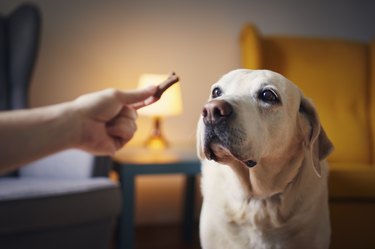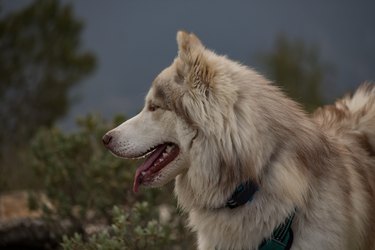You probably know how bad a toothache feels. If you've ever had one, you likely sought out a dentist for relief as soon as possible. However, if your dog has a toothache, it's not just that they can't tell you their mouth hurts — they often actively try to hide it. Given that it's canine instinct to keep any pain or illness hidden, dog toothache symptoms aren't always obvious. If you suspect your dog is having dental pain or tooth issues, monitor them for behavioral changes, chewing issues, excessive drooling, and other signs of dental disease.

Video of the Day
Do dogs get toothaches?
Yes, dogs experience tooth pain as well as painful gums. Just like humans, canines can get gingivitis; periodontal disease; and calculus, or tartar buildup. They can also be affected by bone loss, dental decay, and tooth abscesses if their dental disease becomes severe enough. Left untreated, dental disease can lead to or worsen other health problems in dogs, including heart disease.
Video of the Day
Signs of tooth pain in dogs
Dogs with mild dental issues might not show any signs, but as tooth problems progress, they might display a variety of dog toothache symptoms. It is helpful for pet parents to know what to look for in order to catch toothaches and seek veterinary dental care as early as possible.

Eating difficulties
Tooth pain usually does not cause loss of appetite, but a dog with dental issues might be reluctant to eat because it hurts. In addition, tooth pain can cause your dog to change the way they chew. If you notice your dog dropping food, struggling to pick up food in their mouth, chewing oddly, or chewing only on one side, that could indicate a dental problem. If your dog only wants to eat wet food when they usually love dry food, this could be another clue that they have tooth pain. They might ignore rawhide "chewies" and other treats they usually love.
Bad breath, bleeding gums, and nasal discharge
If your dog starts drooling excessively or their breath smells bad (known in medical terminology as halitosis), decayed or abscessed teeth could be the cause. The saliva might contain blood or appear stringy. You might notice bloody, red, or swollen gums. In addition, your dog might make unusual noises when they eat.
In some cases, if a tooth abscess has spread into the sinuses, you may see bloody or yellow nasal discharge.
Swelling of the face or jaw
Dogs who are suffering from dental pain often dislike having their face or head touched. You might notice swelling of the jaw or facial area. A canine tooth root abscess sometimes looks like an outpouching beneath the eye.
Behavioral changes
If your formerly pleasant pup experiences behavioral change and starts acting grumpy, oral pain could be the cause. You might also catch your dog pawing at their face. While a behavioral change doesn't necessarily mean your dog has dental issues, it does indicate that something is wrong with them. Take them to the veterinarian for an examination, which will include a check of the oral cavity.

Preventing dental issues in your dog's teeth
Your veterinarian should examine your dog's mouth to assess their oral health at their annual wellness examination. The veterinarian will likely recommend that you brush your dog's teeth regularly as well. With daily brushing, you'll notice any symptoms of tooth decay or gum disease early on. Be sure to use a toothpaste formulated specifically for canines, as human toothpaste can be toxic to dogs. Your veterinarian can show you how to brush your dog's teeth and provide you with dog toothbrush and toothpaste recommendations. They can also suggest special diets and chews designed to enhance dental health.
The veterinarian should also advise you on whether or not your pet requires a teeth cleaning. While such cleaning, done under anesthesia, can cost a significant amount of money, it can spare your dog from worsening dental issues and toothaches in the long run. Most dental cleaning procedures also include X-rays to check beneath the gum line, and dogs with severe dental decay, broken teeth, or loose teeth will most likely require tooth extractions.
The bottom line
Dogs can get dental disease, which can lead to canine toothaches. Pet owners can help prevent tooth problems in their dogs by brushing their teeth daily (a veterinarian or veterinary technician can show you how) and making sure to bring them to your DVM (veterinarian) for regular oral checkups and cleanings. If your dog has visibly inflamed or bloody gums, drools excessively, has trouble picking up food or chewing, or has facial swelling, these could all be clues that they have a tooth issue, and they might need a dental procedure to address the problem.